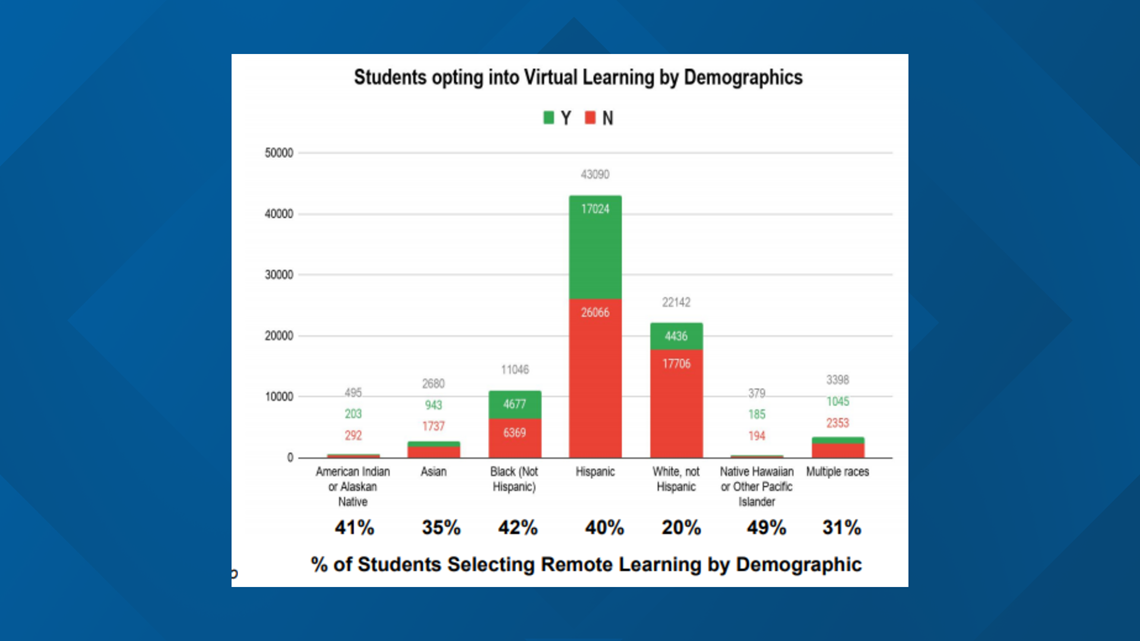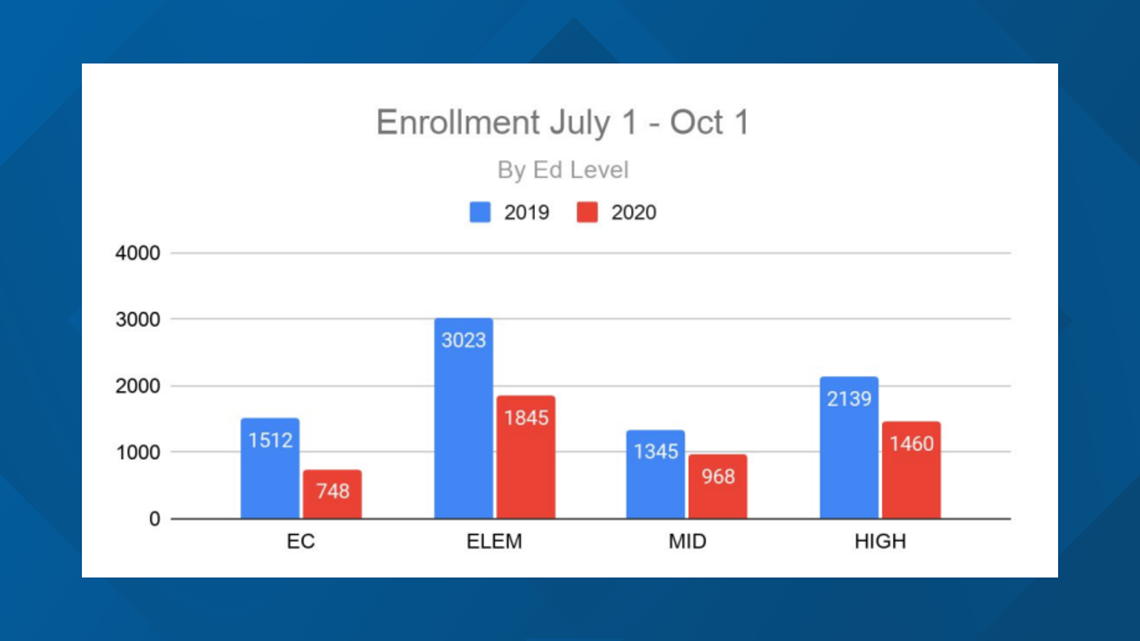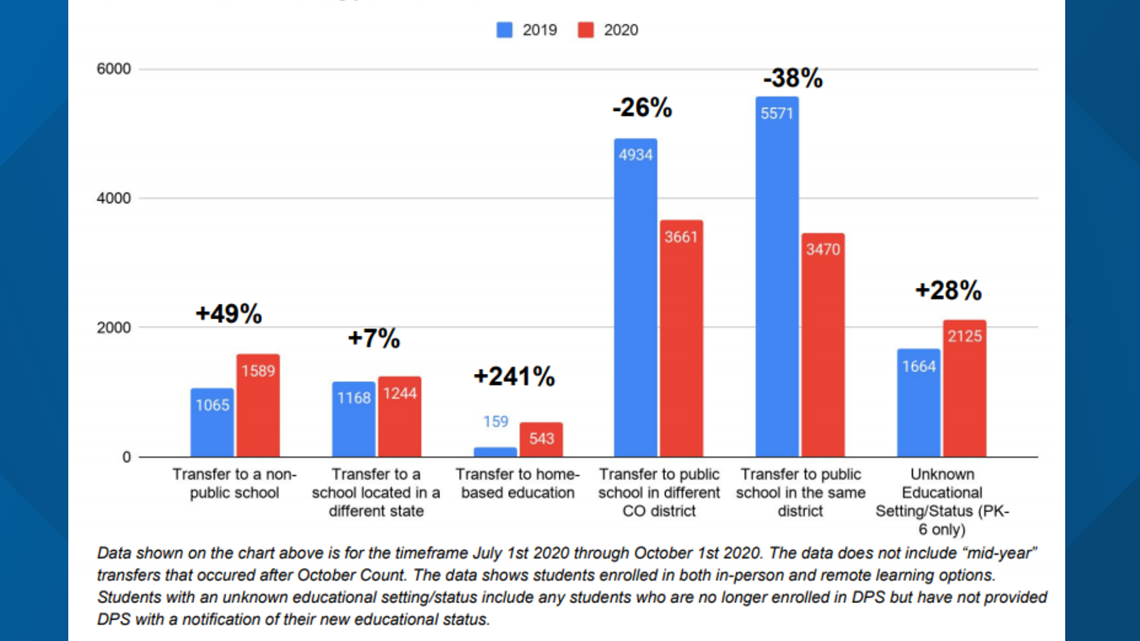DENVER — Students of color within the Denver Public School District (DPS) were significantly more likely to choose remote learning as enrollment saw an unprecedented one-year drop amid the coronavirus pandemic, according to new data from the district.
The Strategic Regional Analysis Report is typically released each fall by the district's planning department. This year, however, is not a typical year due to COVID-19, so the report is shorter and only focuses on a few key indicators of how COVID-19 has impacted enrollment and operations at DPS. It will be followed up in May with a report looking at the district's five-year enrollment forecast.
According to the report, the implications of the COVID-19 pandemic for the district are "numerous."
Below are some key findings:
- District-wide enrollment declined over 3% in one year from 2019-20 to 2020-21 with the most acute drops in preschool and kindergarten.
- Fewer students switched schools within DPS and between public Colorado school districts compared to previous years but significantly more students switched from DPS to private or homeschool options compared to previous years.
- Students of color were significantly more likely to select a remote learning option than their White peers
- Students in the northwest, far northeast and southwest were more likely to choose remote learning than students in other regions of DPS
Remote learning
Learning options changed throughout the semester, however, parents were asked to select whether or not they would utilize an in-person option should it be available based on health conditions.
Families in the far northeast and southwest regions had the highest rates of students opting for a fully remote option. Those are also the regions with the highest rates of students of color and low-income students, according to the SRA.


More than 40% of Latinx, Black and American Indian students selected a remote option, compared to 20% of White students and 35% of Asian students.
Student enrollment
The SRA notes that elementary enrollment has been declining since 2016 but says the district saw an "unprecedented" one-year drop in enrollment from 2019 to 2020 due to the COVID-19 pandemic.
Enrollment was predicted to drop slightly by less than 1%, but in reality, fell more than 3%. The biggest drops were among kindergarten and early childhood education students with enrollment dropping by 3,700 students for grades preschool through five.
The blue bar in chart below represents a typical year while the red represents 2020.


While DPS saw more new enrollments in high school, there was such a dramatic drop at younger grade levels that overall enrollment dropped.
The district is taking a moderate approach to predicting enrollment for next year and expects it to increase "very slightly." They don't expect to see the small decreases seen in years past but also don't expect to reach pre-pandemic levels.
Student inequities
The COVID-19 pandemic has exacerbated inequities that already existed, according to the SRA. DPS data shows that more students of color and low-income students opted for fully remote learning even when in-person options were available.
According to the SRA, possible reasons for that include existing inequities in systems like healthcare, housing and employment.
The SRA also acknowledges that families with more income opted to leave DPS for private or homeschool options, which could further impact per-pupil funding for public districts.
Student mobility
The number of students transferring from DPS to a non-public school increased by about 500 students or roughly 49% from 2019 to 2020, presumably due to the COVID-19 pandemic, the SRA says.
Students transferring to a home-based education option also jumped significantly, by almost 250%, likely due to health and safety concerns or concerns with remote learning options according to the SRA.


Transfers out of state increased marginally by about 7% and the number of students with an "unknown educational status" increased by 28%.
Planning for the future
Moving forward, the SRA notes there are still many questions when it comes to the next school year.
It may be challenging to predict what enrollment will look like this fall because it's unclear if there will be 100% in-person or if students who opted for homeschooling or private schools will return to the district.
It's also possible the Kindergarten class could be larger than in a typical year because many parents chose to delay enrollment, according to the SRA.
The district hopes by spring they'll have a better idea of what next year might look like and hope that information will give them a more accurate picture of the long-term impacts of COVID-19 on enrollment and capacity.
SUGGESTED VIDEOS: Local stories from 9NEWS

